Home Decor
Create an Aging Effect on Vases in 10 Steps
Transform ordinary vases into vintage treasures with 10 steps starting with sanding, adding texture, and finishing touches – discover the secrets!
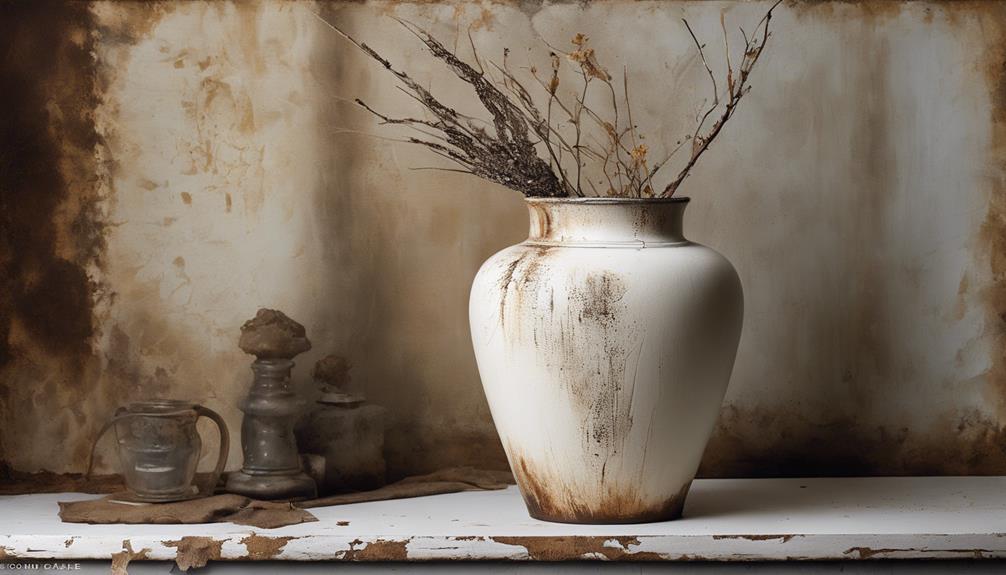
To create an aging effect on vases in 10 steps, start by sanding the vase smooth. Apply an off-white base coat for a vintage look. Add baking soda for texture and mix earthy stone colors for depth. Use a sponge to achieve a weathered appearance. Finish with protective spray. Consider metallic paint, distressed edges, and decorative elements. Keep it budget-friendly with earthy tones, texture, and sealant. Opt for eco-friendly options with natural materials and sustainable practices. For a cost-effective DIY project, follow custom aging techniques, faux finishes, and proper sealing.Transform plain vases into timeless pieces with these steps.
Key Takeaways
- Sand down the vase for proper paint adhesion and to remove imperfections.
- Apply an off-white base coat for even coverage and to set the groundwork.
- Mix baking soda for texture, mimicking natural weathering on stone surfaces.
- Use earthy stone colors with a sponge technique for a weathered look.
- Finish with spray sealant, metallic paint, distressed edges, and decorative elements for an aged aesthetic.
Sanding Down the Vase
When aging vases, we begin by sanding down the surface to guarantee proper paint adhesion. Sanding creates a rough surface that helps the paint adhere better to the vase.
Using fine-grit sandpaper, we scuff up the vase evenly to ensure an ideal base for the aging effect. This process also helps in removing any existing finish or imperfections on the vase, allowing for a smoother application of subsequent coats.
It's essential to sand the entire surface of the vase thoroughly to achieve a consistent aging effect across the entire piece. Proper sanding not only ensures that the paint adheres smoothly but also helps in enhancing the overall quality of the finished aged look.
Applying Off-White Base Coat
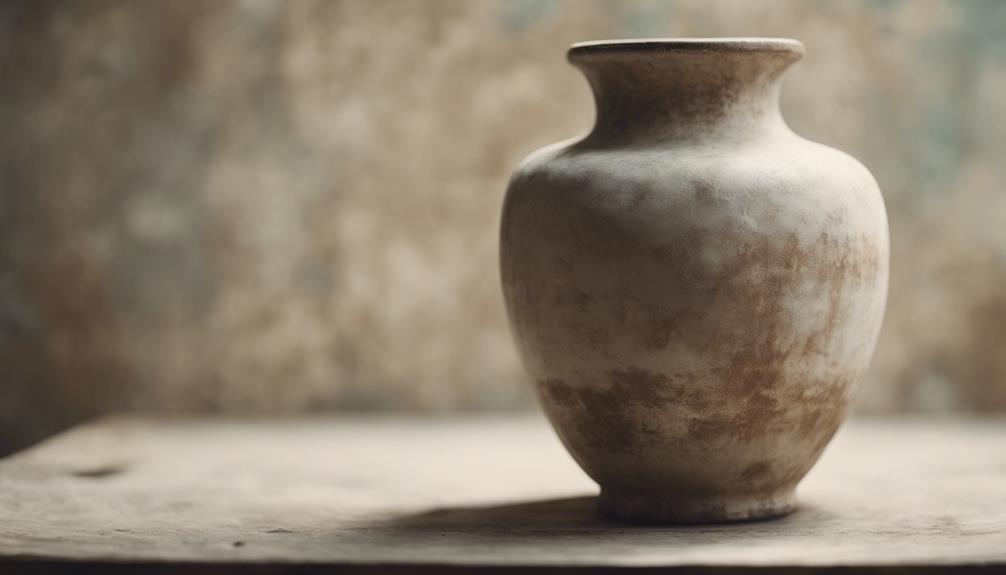
We begin by sanding the vase to create a smooth surface.
Then, we apply an off-white base coat using spray paint, ensuring even coverage.
This base coat lays the groundwork for achieving the desired vintage look on the vase.
Off-White Base Application
To start the process of creating an aged stone effect on a ceramic vase, the first step involves sanding down the surface to enhance paint adhesion.
Once the surface is prepared, we apply an off-white base coat to the vase, adding baking soda for texture. This off-white base coat acts as the foundation for achieving a faux aged ceramic appearance.
By using earthy stone colors and a sponge, we can then create a weathered look on the vase, giving it a realistic and aged appearance. Taking your time during this step is crucial to achieving the desired effect.
Finally, to seal the aged stone effect on the vase and preserve the finish, a protective spray is applied. This step not only protects the surface but also enhances the overall look of the faux aged ceramic vase.
Following these steps carefully will result in a beautifully aged stone effect that adds character and charm to your vase.
Achieving Vintage Look
Sanding down the vase creates a smooth surface for better paint adhesion, setting the stage for applying the off-white base coat to achieve a vintage look.
To achieve this aged appearance, incorporating baking soda into the base coat is essential.
Here's how we can achieve the vintage look:
- Sand the vase thoroughly to guarantee a smooth surface.
- Mix baking soda with the off-white base coat paint for added texture.
- Apply the base coat evenly to create the foundation for the vintage effect.
- Utilize the baking soda mixture to add dimension and create an aged look.
Mixing in Baking Soda for Texture
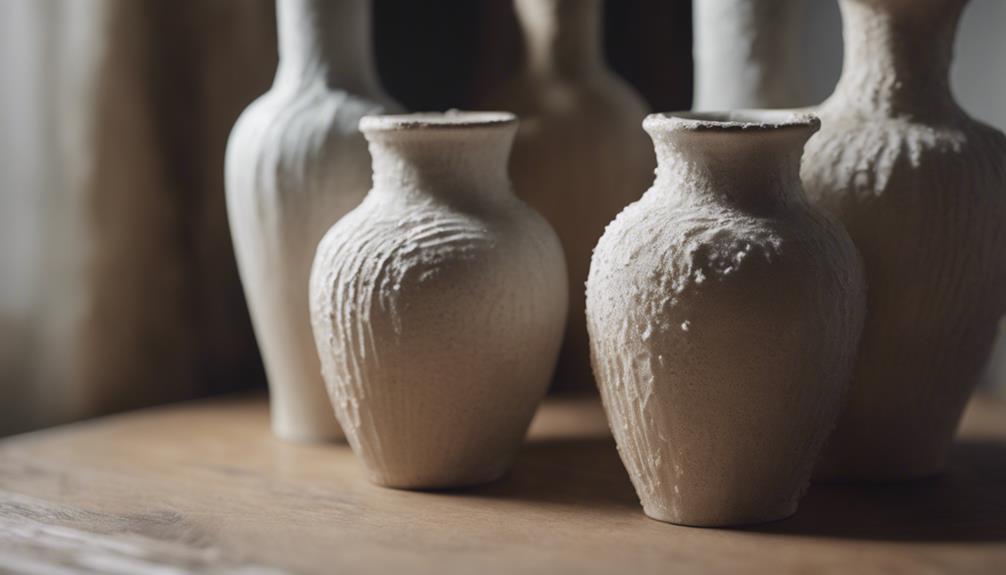
Let's enhance the texture of your vases by incorporating baking soda into the paint mixture for a gritty, aged stone effect. Adding baking soda to paint not only creates a textured finish but also mimics the natural weathering seen on stone surfaces.
This simple technique can be applied using a brush or sponge to achieve depth and dimension in your vase design. The baking soda helps the paint adhere better to the vase's surface, ensuring durability and longevity of the aged look.
Experimenting with different ratios of baking soda to paint allows for customization of the texture level and the degree of aging you wish to achieve on your vases. By adjusting these proportions, you can create varying levels of grittiness and visual interest in your design.
Whether aiming for a subtle weathered appearance or a more pronounced aged effect, incorporating baking soda into your paint mixture is a versatile method to elevate the texture and overall aesthetic of your vases.
Using Earthy Stone Colors
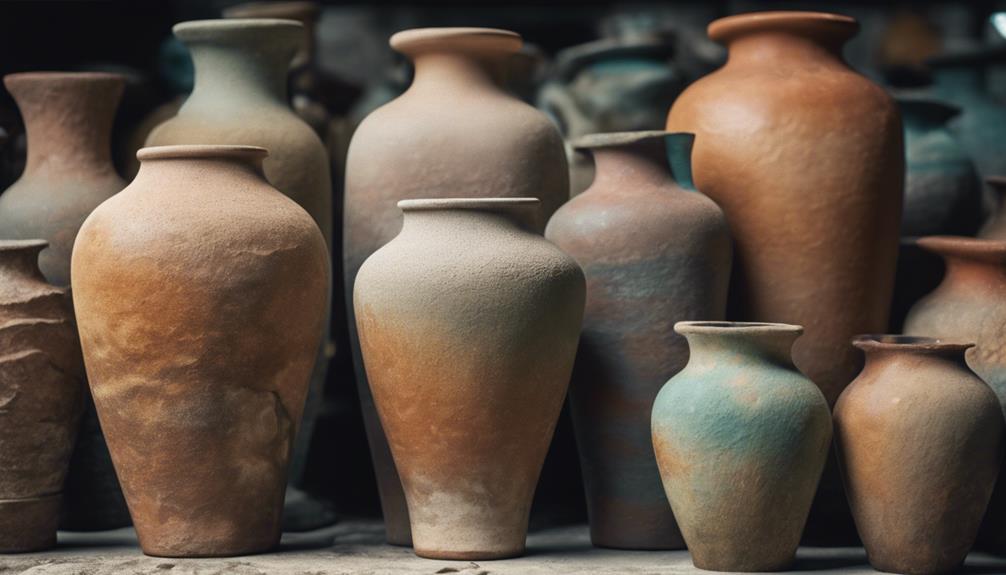
We'll enhance the aged appearance of vases by incorporating earthy stone colors like beige, taupe, and gray. These colors are perfect for transforming a regular vase into one that resembles ancient stone.
Here are some key tips for using earthy stone colors on a stone vase to achieve an aged look:
- Natural Tones: Earthy stone colors such as beige, taupe, and gray closely mimic the hues found in aged stone, giving your vase a realistic weathered appearance.
- Sponge Technique: Applying these earthy stone colors with a sponge can help create a textured and weathered look, adding to the vintage aesthetic of the vase.
- Layering Shades: Layering different shades of beige, taupe, and gray adds depth and complexity to the finish, making the vase look more authentically aged.
- Protective Sealant: After painting, sealing the vase with a protective spray helps maintain the aged stone effect, ensuring its longevity and durability.
Achieving a Weathered Look With a Sponge
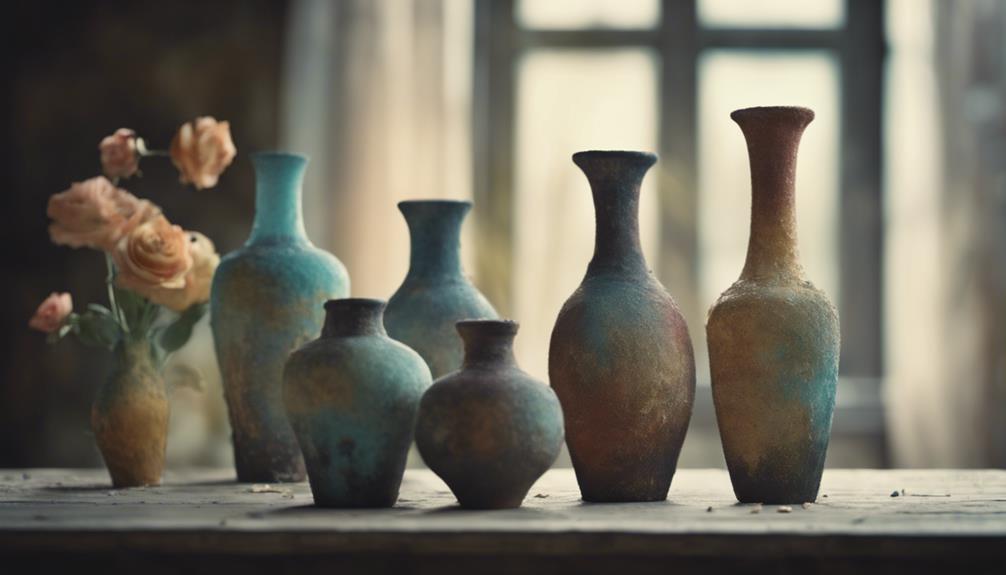
In order to achieve a weathered look on vases, we recommend using a natural sponge to apply earthy stone colors. Lightly dabbing the sponge on the vase will create a textured and aged appearance.
It's crucial to blend different stone colors and experiment with varying pressure and angles for a realistic weathered effect.
Sponge Application Technique
For achieving a weathered look on vases, the sponge application technique is a simple yet effective method.
When using a sponge for painting, consider the following tips:
- Varied Textures: Experiment with different sponge textures to create unique aging effects on the vase surface.
- Light Dabbing: Lightly dab the sponge in paint to achieve a subtle distressed look on the vase.
- Gentle Pressing: Gently press the paint-soaked sponge onto the vase for a realistic aged appearance.
- Layering and Blending: Blend colors and layer paint using the sponge technique to add depth and dimension, enhancing the aging effect.
Blending for Realism
Exploring the art of blending for realism when achieving a weathered look with a sponge involves using natural sea sponges and layering paint to create depth and dimension on vases.
To start, dab the sponge in a base color, then gradually add darker shades to build up the aged effect. Varying the pressure and angle of the sponge helps mimic the natural wear and tear that occurs over time.
The key to achieving a realistic weathered look is to blend the colors seamlessly, ensuring a natural and authentic appearance. Experimenting with different sponge sizes and textures can further enhance the aged stone effect on the vase, allowing for a unique finish.
Sealing the Vase
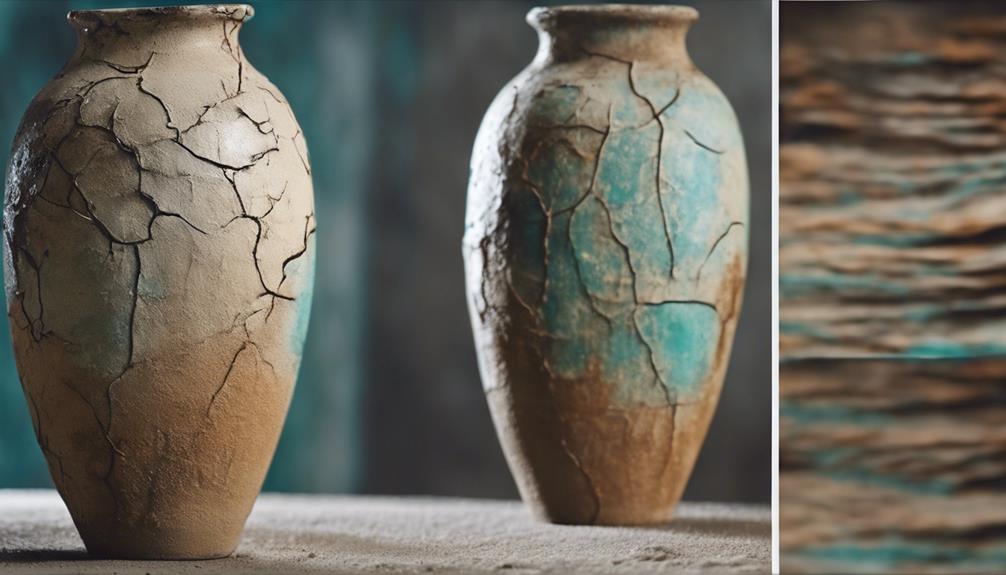
We need to seal the vase to preserve its aged effect and guarantee its longevity. Sealing the vase with a clear protective spray or varnish is essential in maintaining the authenticity of the aged appearance.
Here are key points to take into account when sealing the vase:
- Protection: Sealing the vase helps safeguard the painted surface, preventing chipping, fading, and other damage that could compromise the aged effect.
- Durability: The sealant provides a sturdy layer that shields the vase from wear and tear, ensuring the aged finish remains intact.
- Enhanced Appearance: Sealing the vase results in a smooth and polished surface, enhancing the overall look of the aged effect.
- Longevity: Properly sealing the vase ensures that the aging effect endures over time, even with regular handling and cleaning.
Adding Protective Spray
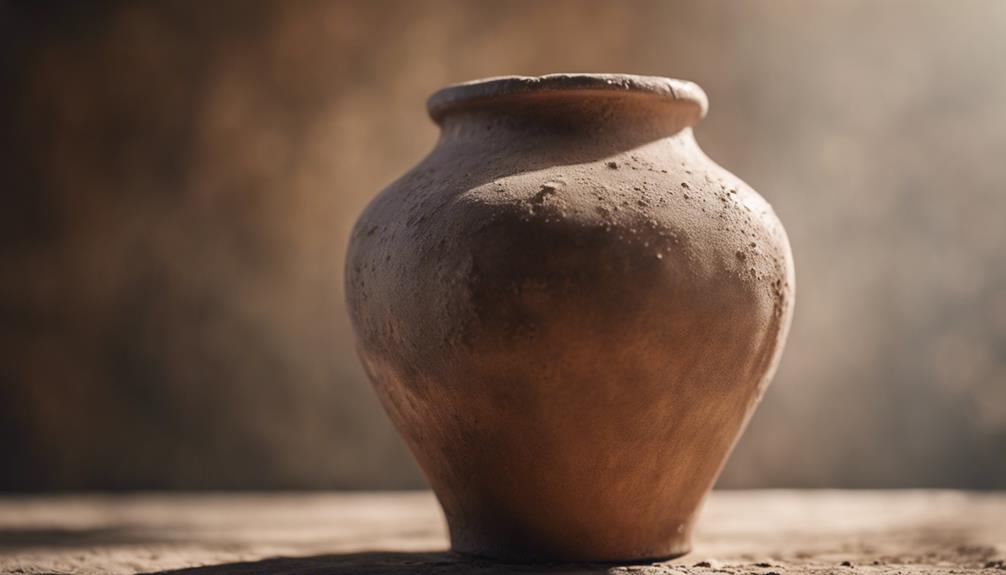
Let's apply the protective spray to the vase to seal and safeguard its aged finish. This step is vital in ensuring the longevity and durability of the aged effect we've carefully created. By adding the protective spray, we create a shield that helps prevent the paint from chipping or fading over time.
Not only does the spray protect the finish, but it also adds an extra layer of durability to the vase, making it easier to clean and maintain.
Choosing a clear protective spray designed for painted surfaces is essential for achieving the best results. This type of spray will enhance the overall look of the aged effect, giving it a polished finish that will last for a long time.
The protective spray acts as a barrier, sealing in the aged finish and ensuring that your vase remains looking beautiful for years to come.
Finishing Touches
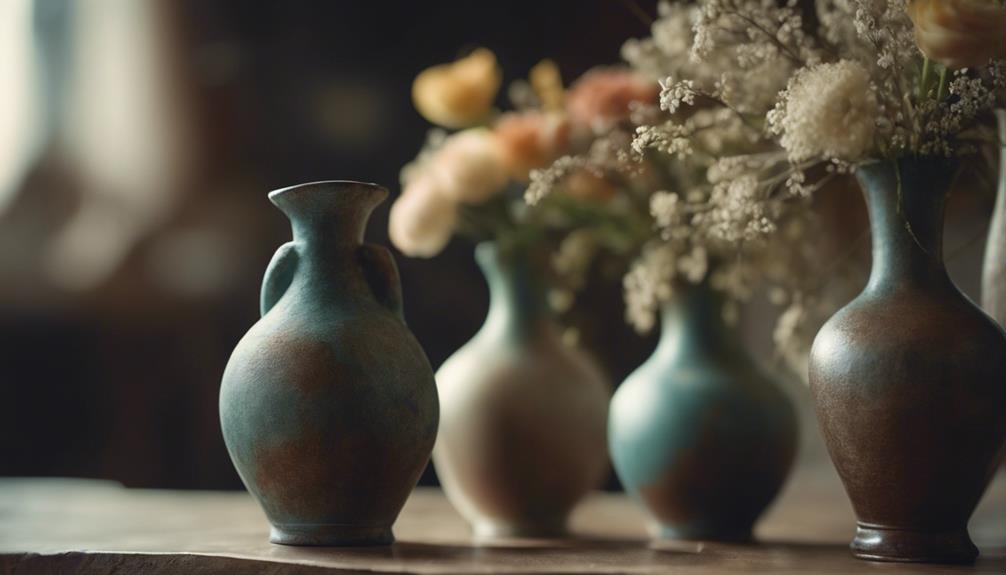
For added elegance and personalization, consider incorporating subtle touches to enhance the aged effect on the vase. Here are some finishing touches to perfect the antique look on your ceramic vase:
- Spray Sealant: Apply a protective spray coat to seal the aged finish, ensuring longevity and preventing chipping.
- Metallic Paint: Add a touch of metallic paint for a shimmering effect that contrasts beautifully with the aged surface.
- Distressed Edges: Use sandpaper lightly along the edges to distress them, creating a more natural and weathered appearance.
- Decorative Elements: Experiment with twine, ribbon, or dried flowers to further customize the aged vase and harmonize with your decor style.
These finishing touches will elevate the overall aesthetic of your ceramic vase, providing a unique and aged look that adds character to your space.
Cost-Effective DIY Project
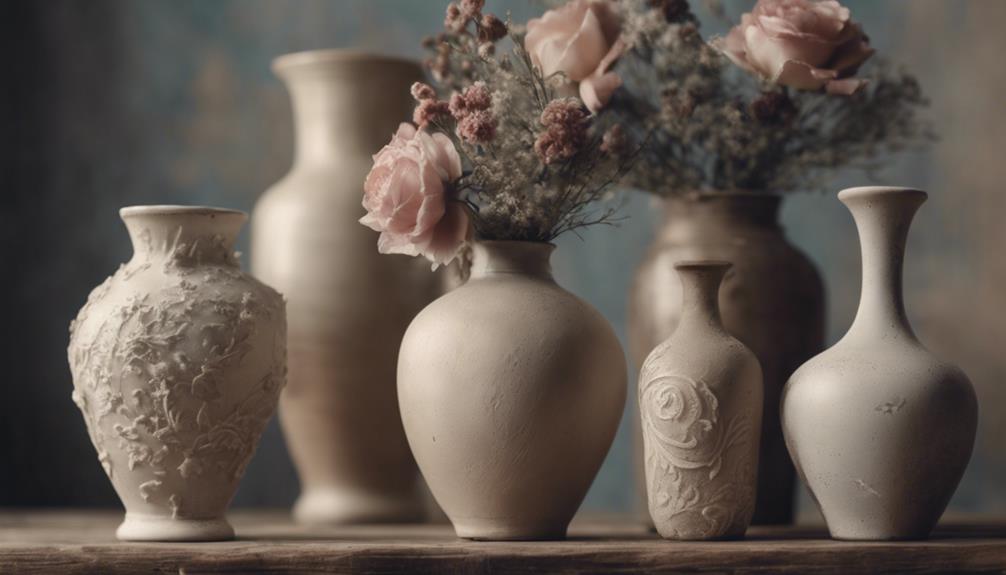
Transforming vases on a budget is achievable through simple and cost-effective DIY aging techniques. By using basic materials like paint, sandpaper, and varnish, you can effortlessly create an aged effect that enhances your home decor.
Customizing vases with faux antique finishes not only adds a unique flair but also promotes eco-friendly upcycling practices.
Budget-Friendly Vase Transformation
With a few simple materials like paint, sandpaper, and varnish, we can easily transform a vase into an aged masterpiece. Here are some budget-friendly tips to elevate your vase turning it into a stunning aged piece:
- Choose the Right Colors: Opt for earthy tones like beige, brown, or grey for a natural weathered look.
- Add Texture: Consider using dirt or mud to create a textured appearance that enhances the aging effect.
- Distress with Sandpaper: Gently sand the vase after painting to distress the surface and give it a worn-out look.
- Seal with Varnish: Finish off your DIY project by sealing the vase with varnish to protect the aged finish and add a subtle sheen.
Simple DIY Aging Technique
To achieve a beautifully aged look on a vase without breaking the bank, consider utilizing a simple DIY aging technique that's both cost-effective and straightforward. Start by sanding down the vase to create a rough surface for better paint adhesion.
Next, apply an off-white base coat mixed with baking soda to add texture and character to the vase. Utilize earthy stone colors and a sponge to create a weathered appearance, mimicking the natural aging process.
Once you've achieved the desired look, seal the vase with a protective spray to preserve the aging effect for the long term. By following these steps, you can transform a regular vase into one that resembles an expensive aged stone piece, all with simple and budget-friendly methods.
This technique offers a creative way to add depth and personality to your decor without spending a fortune on new items.
Eco-Friendly Vase Makeover
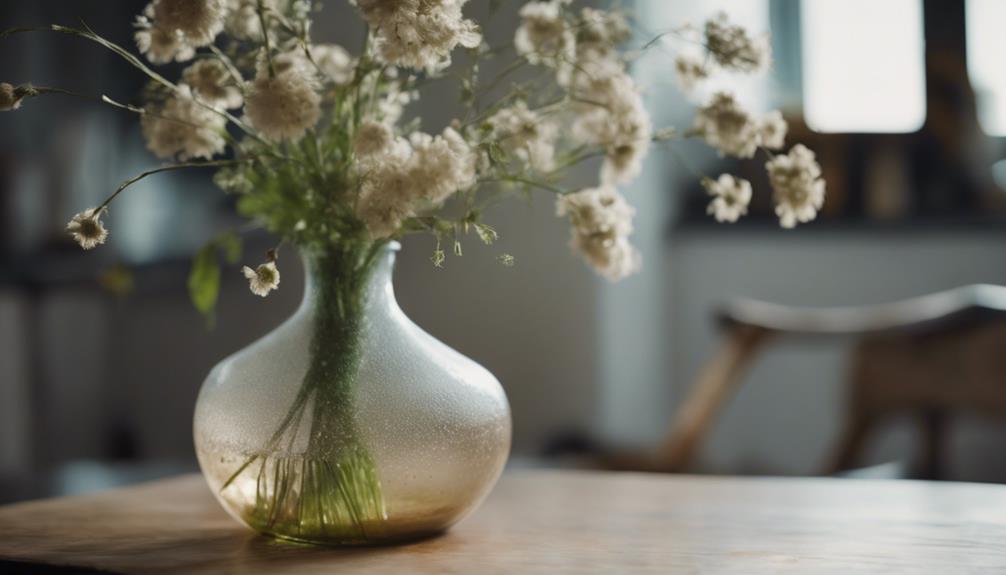
Let's explore how giving old vases an eco-friendly makeover can enhance their aesthetic appeal while promoting sustainability.
When upcycling old vases, we not only reduce waste but also contribute to a more environmentally friendly lifestyle. Using natural materials like dirt and sandpaper allows for the creation of an eco-friendly aging effect that adds a unique charm to the vases.
DIY vase makeovers provide an opportunity for personalization and creativity, all while avoiding the need to purchase new items. Transforming vases with aging techniques not only breathes new life into old pieces but also adds character and warmth to your home decor.
These eco-friendly vase makeovers aren't only cost-effective but also align with environmentally conscious practices, offering a sustainable alternative to buying new decor items. By embracing upcycling and aging techniques, we can revitalize our vases in a way that benefits both our homes and the planet.
Frequently Asked Questions
How Do You Make a Vase Look Older?
To make a vase look older, we can use various techniques. Sanding the surface for paint adhesion is essential.
Layering flat spray paint in desired colors creates an aged appearance. Adding dirt or mud while the paint is wet can enhance texture. Optionally, using mortar or spackling can further the aged look.
Finish by sanding excess texture and applying a final paint coat for a realistic aged stone effect.
How to Make a Vase Look Distressed?
To make a vase look distressed, we scuff it with sandpaper for paint adhesion.
Adding spackling or joint compound enhances texture.
Using a mix of white paint and baking soda creates a stone-like finish.
Incorporating dirt or mud in painting boosts the weathered effect.
Seal the vase with protective spray for a lasting aged appearance.
These steps transform a vase into a distressed piece with character and charm.
How to Create Texture on a Vase?
To create texture on a vase, start by scuffing the surface with sandpaper for a rough base.
Mix paint with baking soda or salt for added texture, then apply using a sponge or dry brush technique for a weathered look.
Consider incorporating dirt or mud for an authentic aged effect.
Seal the vase with a protective spray to maintain the texture and finish.
These steps will help achieve a textured and aged appearance on your vase.
How to Make a Vase Look Like Pottery?
To make a vase look like pottery, we sand it down for better paint adhesion. Mixing off-white paint with baking soda creates a pottery-like texture.
Then, we use earthy stone colors and a sponge to give the vase a weathered appearance. Sealing it with a protective spray preserves the effect.
With these steps, we transform a plain vase into a beautiful pottery-inspired piece.
Conclusion
To wrap up, aging vases in 10 simple steps can give your home decor a charming vintage touch. Remember, 'old is gold' when it comes to creating a weathered and textured look for your vases.
This cost-effective DIY project isn't only eco-friendly but also a fun way to express your creativity. So grab your supplies and get ready to transform your plain vases into beautiful pieces with a touch of age and character.
Home Decor
Must-Have August Home Accessories for a Stylish Update – Don’t Miss These!
Must-have August home accessories await to transform your space—discover the stylish updates that could elevate your decor!
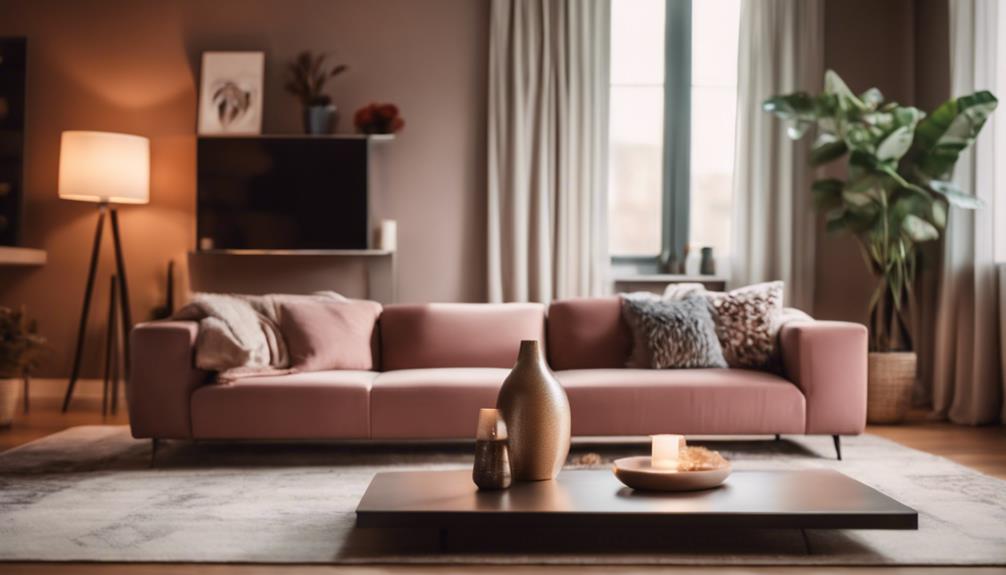
August is your chance to elevate your home decor with stylish accessories. Start with chic faux leather pillow covers for a trendy touch. Oversized artwork not only makes a statement but also sparks conversations. Don't overlook affordable hurricane vases; they brighten up your space with seasonal florals. Transform your lamp shades to enjoy a refreshed ambiance. For added sophistication, include coffee table books showcasing black and white photography. These must-haves will breathe new life into your home. Stick around, and you'll discover even more stylish updates that can complement your unique taste!
Key Takeaways
- Incorporate stylish faux leather pillow covers for texture and seasonal contrast in your home decor.
- Use oversized artwork as a striking focal point and conversation starter in any room.
- Add affordable hurricane vases to enhance floral arrangements and bring seasonal ambiance indoors.
- Transform existing lamp shades with darker tones to elevate the overall room ambiance.
Essential Textiles for August
August's essential textiles, like stylish faux leather pillow covers and oversized artwork, can instantly elevate your home decor for the season. These textiles not only enhance your space but also provide a chic upgrade that reflects your personal style. By incorporating unique decorative accents, you can create a warm and inviting environment that feels refreshed and seasonal.
When it comes to budget-friendly options, don't overlook affordable hurricane vases and florals, which can add a pop of color and life without breaking the bank. Transform existing textiles, such as lamp shades or table runners, to give your home a renewed look that's both practical and visually appealing.
Engaging in local shopping experiences is a great way to discover distinctive textiles that stand out from mass-produced items. You'll find unique pieces that not only elevate your home decor but also support your community.
Embrace these essential textiles this August as you make seasonal updates to your living space. With a little creativity and the right elements, your home can transform into a stylish oasis you'll love coming home to.
Unique Decorative Accents
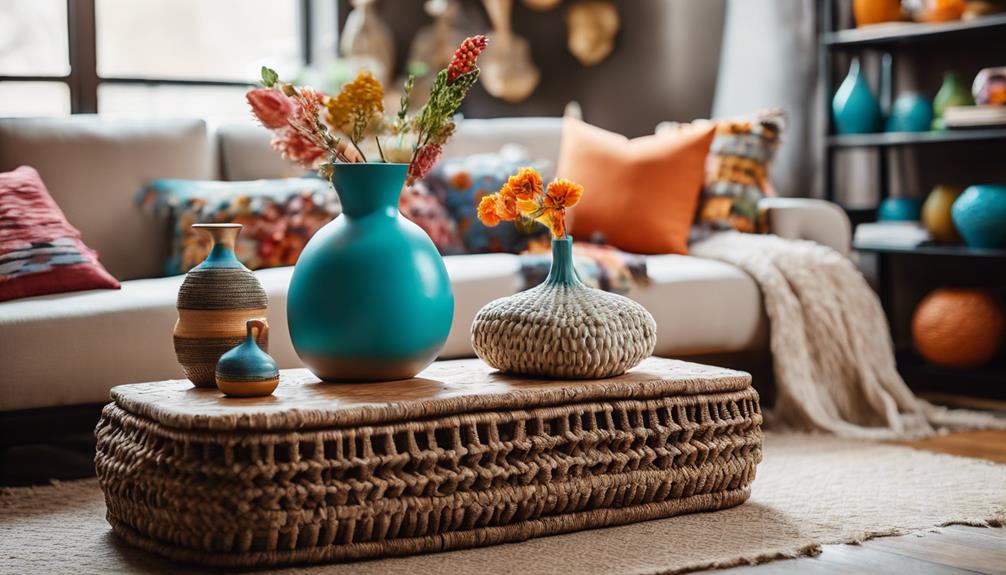
To truly elevate your home decor, incorporating unique decorative accents can make all the difference, turning ordinary spaces into personal showcases of style and creativity.
Start with oversized artwork that serves as a striking conversation starter, allowing you to express your individuality. Faux leather pillow covers add texture and contrast, making them perfect for seasonal updates, especially as you shift into fall.
Don't overlook the impact of decorative pieces like hurricane vases. They're not only budget-friendly but also enhance your floral arrangements, bringing seasonal ambiance to any room. You can fill them with seasonal blooms or even decorative stones for a chic look.
A stylish living space isn't complete without a well-placed coffee table book, particularly one featuring stunning black and white photography. This not only acts as an aesthetic element but also provides inspiration and a touch of sophistication.
Seasonal Color Trends

Embracing seasonal color trends can transform your home, making it feel fresh and inviting with each change of the year. By incorporating these colors into your home decor, you can align with current consumer preferences while achieving a stylish update.
| Season | Color Palette |
|---|---|
| Spring | Pastel colors |
| Summer | Vibrant hues |
| Fall | Earthy tones |
| Winter | Cool colors |
| Year-Round | Neutrals and metallics |
In the spring, soft pinks, light greens, and baby blues breathe life into your space, reflecting renewal. Summer calls for bright blues, sunny yellows, and lush greens that bring the outdoors in. As fall approaches, embrace warm earthy tones like burnt orange and deep burgundy, creating cozy, inviting spaces. Finally, winter encourages cooler hues, like icy blues and deep greens, that add elegance during the holidays.
Incorporating these seasonal colors through accessories can enhance your home's overall aesthetic. Whether it's throw pillows, vases, or artwork, these touches will keep your home feeling timely and reflective of the season's beauty.
Creative Home Accessories
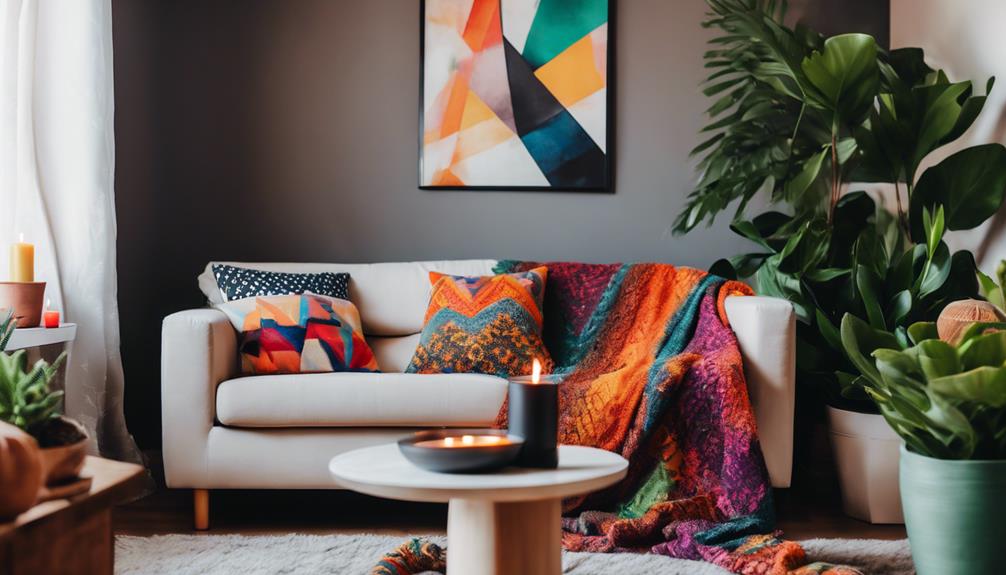
Seasonal color trends set the stage for a revitalizing update, and adding creative home accessories can elevate your decor even further.
Oversized artwork can serve as a stylish conversation starter, infusing your space with character while keeping things budget-friendly. Consider incorporating decorative accents like coffee table books featuring black and white photography to add a touch of sophistication and visual interest to your living room.
Faux leather pillow covers are perfect for enhancing the texture of your home decor. They provide a trendy contrast that's ideal for those seasonal updates. Alongside these, transforming lamp shades is an effective way to refresh your home. Opt for darker shades to elevate the style and ambiance of any room, making it feel more inviting.
Don't forget about affordable florals! You can easily source fresh arrangements from local stores, giving your space that vibrant, seasonal touch without breaking the bank.
Budget-Friendly Decor Ideas
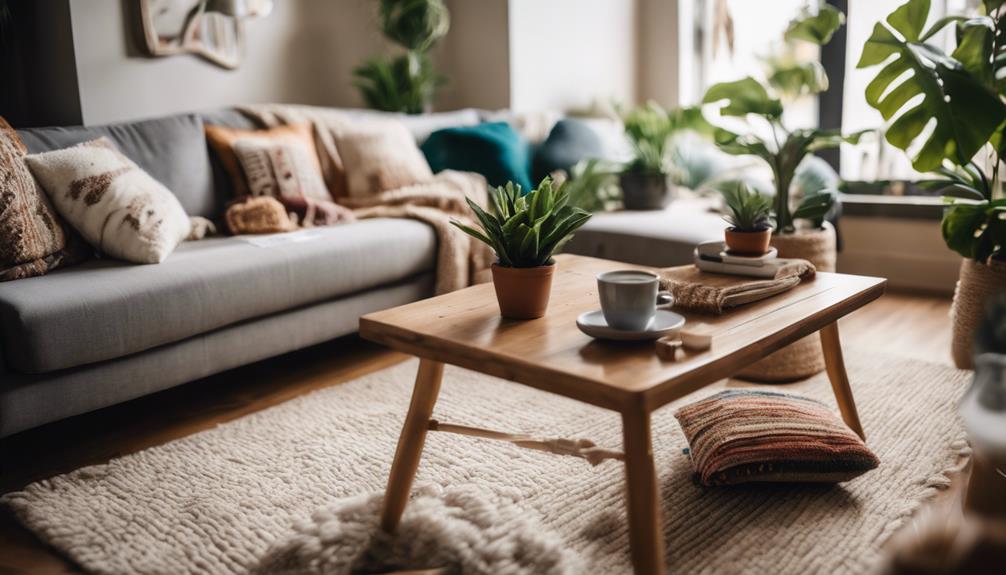
Discover how budget-friendly decor ideas can transform your space into a stylish haven without draining your wallet.
Start by exploring budget-friendly decor items that bring elegance and charm to your interiors. Keep an eye on monthly sales and clearance finds to uncover unique home accents that elevate your style at a fraction of the cost.
Consider incorporating oversized artwork or unconventional pieces as conversation starters, adding character to your rooms while staying within budget.
DIY projects are another fantastic way to personalize your space; get creative and make decor that reflects your personality without spending a fortune.
Don't overlook thrifted items, which can often be gems waiting to be discovered. They not only save you money but also contribute to a distinctive aesthetic.
To stay inspired, join online communities or follow channels dedicated to budget decorating. These platforms are treasure troves of tips and tricks to help you maximize style without overspending.
Frequently Asked Questions
What Is an August Smart Lock?
An August Smart Lock lets you control your door remotely using your smartphone. You can create unique access codes for guests and enjoy keyless entry, all while keeping your existing keys and enhancing security effortlessly.
Are Yale and August the Same Company?
Yes, Yale and August are part of the same parent company, Assa Abloy. Both brands focus on smart lock technology, enhancing home security and convenience, but they offer different features and installation options.
How Many Generations of August Smart Lock Are There?
You might think all smart locks are the same, but August Smart Lock has evolved through four generations. Each one enhances security and convenience, ensuring you stay ahead in home automation technology without compromising on ease of use.
What Is the Best Automatic Door Lock in 2024?
When choosing the best automatic door lock in 2024, consider the August Wi-Fi Smart Lock for its direct connectivity and advanced security features, or the Yale Approach™ for seamless smart home integration and ease of use.
Conclusion
To wrap it up, updating your home with stylish accessories this August doesn't have to break the bank.
For example, think about how a simple, vibrant throw pillow can transform your living room's vibe. You'll not only refresh your space but also create a cozy atmosphere for gatherings.
Embrace these must-have items and let your home reflect your personal style while staying on-trend.
Get ready to enjoy a renewed space that feels just right for the season!
Home Decor
No, Your Scandinavian Kitchen Doesn't Have to Be All White
Transform your Scandinavian kitchen with vibrant colors and textures that defy the all-white norm—discover how to make it truly yours!
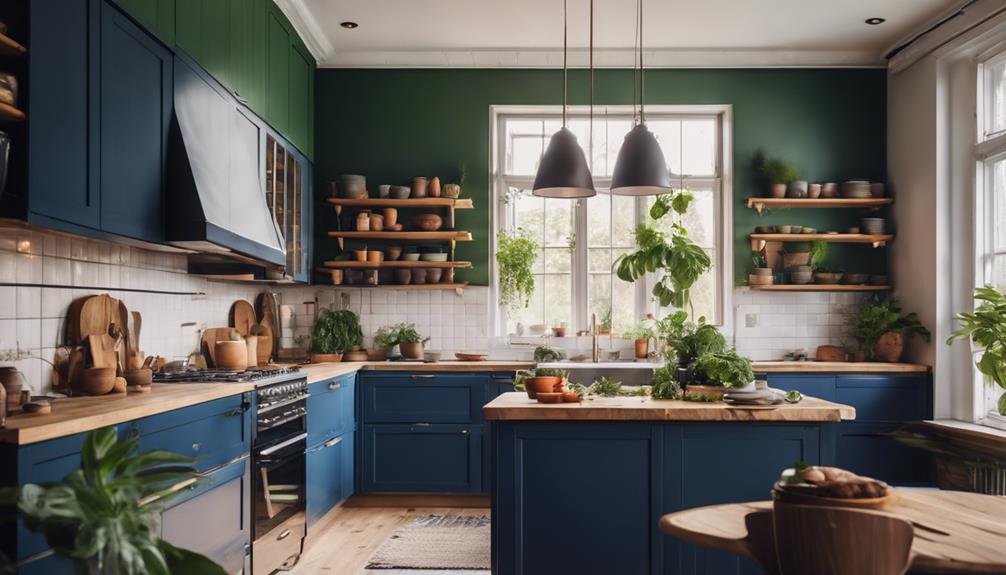
No, your Scandinavian kitchen doesn't have to be all white. You can embrace soft pastels, muted tones, and even bold accents to create a vibrant space. Think about colorful cabinetry paired with natural materials like wood and stone for warmth and texture. Light fixtures can act as eye-catching focal points while layered textiles add depth and personality. And don't forget about flooring options such as engineered hardwood or cork. It's all about mixing colors and textures to make your kitchen uniquely yours. Stick around, and you'll uncover more ideas on how to transform your space.
Key Elements
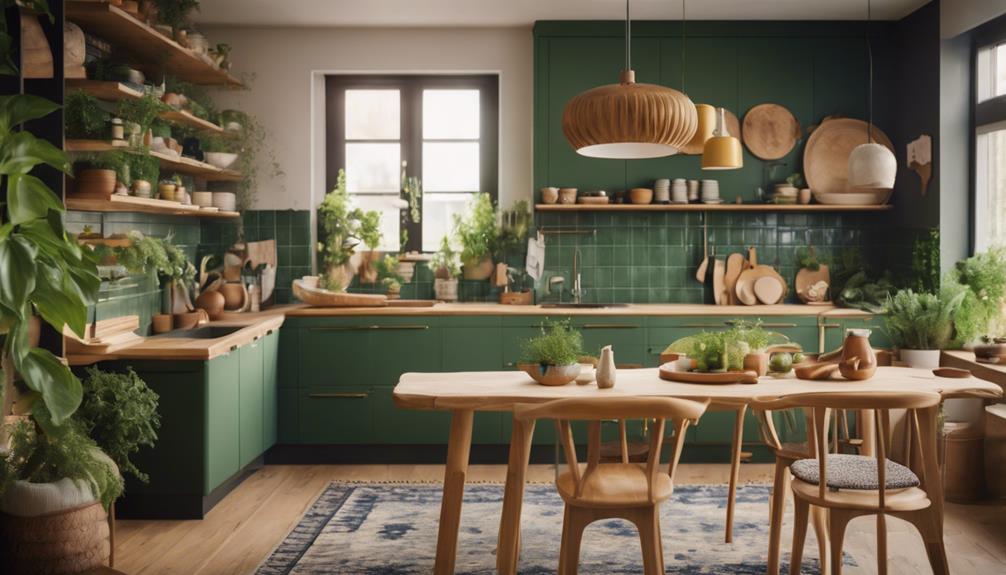
When you think about Scandinavian kitchen design, the key elements like color scheme, materials, and textures come into play.
You'll find that soft pastels and natural materials create a warm and inviting space.
Mixing textures adds depth, making your kitchen feel both functional and stylish.
Color Scheme
A vibrant color scheme in Scandinavian kitchen design goes beyond traditional whites, incorporating soft pastels, muted tones, and bold accents to infuse warmth and personality into the space. Embracing Scandi style means you don't have to settle for a sterile look; you can play with colors that reflect your taste.
Consider white walls as your canvas, allowing colorful cabinetry and accessories to pop. Soft blues, gentle greens, and warm yellows can create a welcoming atmosphere, while bold colors can serve as eye-catching focal points. This mix enhances visual interest without sacrificing the clean lines that define Scandinavian aesthetics.
Don't shy away from mixing textures and patterns either—this adds depth to your kitchen while maintaining a minimalist appeal. By strategically placing accent colors, you can create a balance between comfort and simplicity, ensuring your kitchen feels inviting yet organized.
The use of natural materials like wood and stone complements these colorful elements, reflecting your personal style while staying true to the functional ethos of Scandi design. So go ahead and experiment; your Scandinavian kitchen can truly be a vibrant expression of who you are.
Materials
Scandinavian kitchen design thrives on a mix of materials like natural wood, stone, and concrete, enhancing warmth and texture while maintaining simplicity. While white cabinetry remains popular, incorporating bleached wood accents can create a balanced aesthetic that adds depth without overwhelming the space. This combination keeps the design true to Scandinavian principles while introducing a touch of color.
Durable materials are also essential in this style. Quartz countertops and recycled components are increasingly favored, allowing you to promote sustainability without sacrificing elegance. Using stone or concrete elements can ground the design, providing a sturdy, earthy contrast to the often light and airy feel of white surfaces.
Don't shy away from integrating textured elements, like patterned tiles or metal fixtures, as they can add visual interest and break up the monotony of a mainly white palette. Accessories, furniture, and decor in vibrant colors can further infuse your kitchen with personality, moving beyond the all-white norm.
Textures
Incorporating a variety of textures, from soft textiles to sleek metals, adds depth and warmth to your Scandinavian kitchen, steering clear of a stark all-white aesthetic. Mixing materials, such as concrete tiles with wooden cabinetry, creates visual interest and aligns with contemporary Scandinavian trends. You can enhance this balance by introducing textured elements like woven baskets and ceramic dishes, which not only serve as functional decor but also contribute to the cozy, lived-in atmosphere typical of Scandinavian homes.
Layering different textures is key; imagine a plush rug underfoot paired with smooth countertops, promoting a tactile experience that invites engagement. This thoughtful approach encourages comfort and makes your kitchen feel more welcoming.
Additionally, consider using contrasting finishes, such as matte versus glossy surfaces. This interplay can highlight architectural features and prevent your kitchen from feeling monotonous.
Essential Fixtures and Furniture
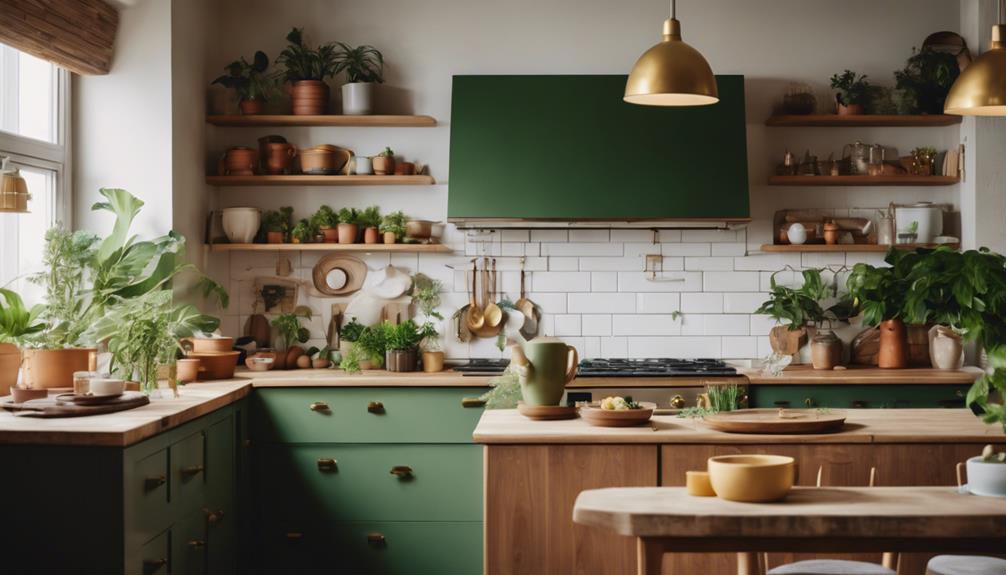
When designing your Scandinavian kitchen, choosing essential fixtures and furniture is vital for achieving that signature look.
A sleek Scandinavian sink paired with a minimalist pull-down faucet not only enhances functionality but also aligns with your aesthetic.
Don't forget to incorporate stylish pendant lighting to create an inviting atmosphere while illuminating your workspace.
Sleek Scandinavian Sink Design
A sleek sink design in your kitchen can elevate both functionality and style, embodying the essence of Scandinavian aesthetics. Scandinavian design often prioritizes clean lines and minimalistic forms, guaranteeing your sink seamlessly integrates into modern kitchen layouts. Opting for durable materials like stainless steel or composite not only enhances the sleek appearance but also assures longevity.
Consider an under-mount sink, a popular choice that creates a streamlined look and simplifies cleaning compared to traditional drop-in models. In Scandinavian kitchens, large, deep sinks are common, allowing you to handle both cooking and cleaning tasks with ease. Pairing these sinks with high-arc faucets adds further functionality while maintaining the minimalist vibe.
Don't forget about accessories! Cutting boards and colanders designed to fit over your sink can maximize workspace without compromising the clean aesthetic central to Scandinavian design. This thoughtful approach to sink selection guarantees that your kitchen remains not only stylish but also practical for daily use.
Minimalist Pull-Down Faucet
The sleek design of a minimalist pull-down faucet perfectly complements the streamlined aesthetics of Scandinavian kitchens, enhancing both functionality and style.
When you choose a faucet with a clean, modern silhouette, you're elevating the overall Scandi look while ensuring practicality in your space. These fixtures usually come in durable materials like stainless steel or matte black finishes, adding a contemporary touch that pairs well with your design scheme.
The pull-down feature is a game changer, allowing you to easily maneuver the faucet for various kitchen tasks.
Whether you're rinsing dishes or filling large pots, you'll find the increased reach incredibly convenient. Plus, many of these faucets utilize a single-handle design, promoting simplicity and ease of use, which is essential for maintaining a clutter-free countertop.
Scandinavian-Style Pendant Light
Scandinavian-style pendant lights enhance your kitchen's aesthetic with their clean lines and minimalist designs, ensuring both beauty and functionality. These essential fixtures often feature natural materials like wood and metal, reflecting the Scandi emphasis on simplicity and practicality in kitchen design.
You'll find that statement lighting—like oversized or uniquely shaped pendant lights—can act as enchanting focal points, adding character and warmth to your space. Placing pendant lights above kitchen islands or dining areas is a common practice in Scandinavian design, fostering social interaction and creating a cozy atmosphere that invites gatherings.
When selecting pendant lights, consider brands like Muuto and Gubi, which offer a range of options that blend contemporary design with traditional Nordic elements. This approach allows you to cater to diverse style preferences while maintaining the minimalist essence of Scandi design.
Lighting Ideas
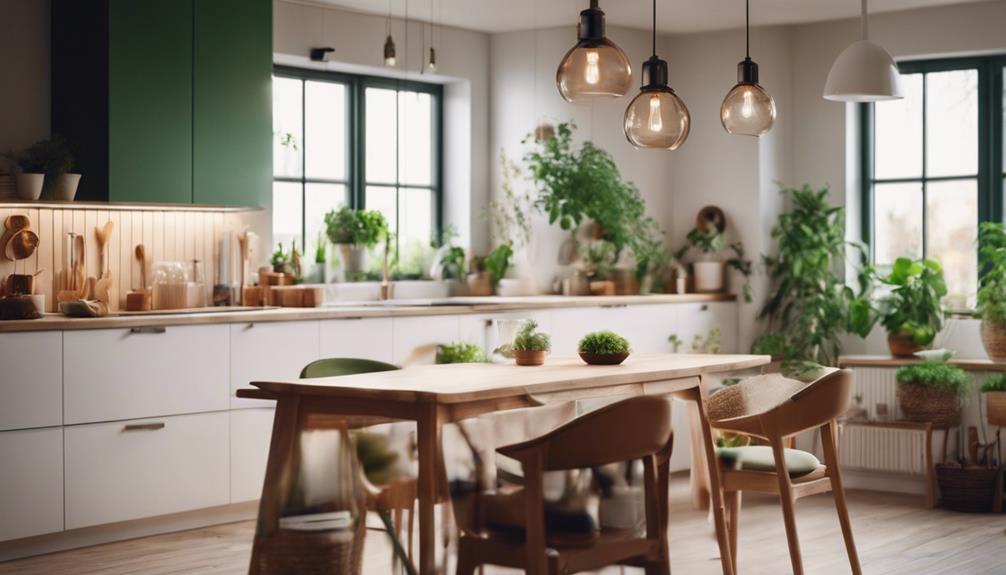
When it comes to lighting in your Scandinavian kitchen, you can transform the space with a mix of warm LED under-cabinet lights and statement pieces featuring geometric shapes.
Maximizing natural light through large windows and mirrors not only brightens the room but also enhances its airy feel.
Additionally, consider recessed ceiling spotlights for a sleek look that complements the overall design while providing functional illumination.
Warm LED Under-Cabinet Lighting
Enhancing your kitchen's ambiance with warm LED under-cabinet lighting not only creates a cozy atmosphere but also highlights the beauty of your cabinetry and countertops. This lighting solution is perfect for Scandinavian kitchens, as it adds warmth to wood and colored cabinetry while softening the starkness often found in all-white designs.
Warm LED under-cabinet lighting is energy-efficient, consuming up to 75% less energy than traditional incandescent bulbs, making it a sustainable choice for eco-conscious homeowners. You can choose from various color temperatures, typically ranging from 2700K to 3000K, to complement the soft pastels and muted tones common in Scandinavian interiors.
Not only does this lighting improve visibility for meal preparation, but it also creates depth and dimension, effectively showcasing the textures and patterns of your cabinets and countertops. By strategically placing warm LED strips or fixtures, you can foster a cozy ambiance in the evenings, encouraging social interaction and relaxation in your kitchen space.
Natural Light Maximization Techniques
Maximizing natural light in your kitchen can transform the space into a bright and inviting area, perfectly aligned with the airy essence of Scandinavian design.
Start by incorporating large windows or glass doors, which not only invite abundant natural light but also create a seamless connection with the outdoors.
To further enhance the light, use reflective surfaces like glossy cabinets or metallic accents; these bounce light around the room, amplifying brightness. Opt for light-colored walls and countertops to improve light reflection, making your kitchen feel more spacious and open.
If your kitchen lacks wall space for windows, consider installing skylights or light tubes. These features allow natural light to flood in from above, illuminating the space beautifully.
Additionally, open shelving can help avoid visual clutter and permit light to flow freely. This not only showcases the beauty of your kitchen items but also emphasizes the natural light that pours in.
Recessed Ceiling Spotlights
Recessed ceiling spotlights perfectly complement the natural light strategies you've implemented, offering a sleek and minimalist lighting solution that enhances the Scandinavian kitchen aesthetic. These fixtures not only provide ample illumination but also blend seamlessly into your ceiling, maintaining the clean lines characteristic of Scandinavian design.
By strategically placing recessed ceiling spotlights, you can highlight key areas like countertops and dining spaces. This approach enhances both functionality and visual appeal, ensuring your kitchen feels both inviting and efficient. Plus, many of these lights are dimmable, allowing you to adjust the brightness for various moods and activities, making your kitchen versatile for cooking, entertaining, or relaxing.
If you're committed to sustainable living, consider using energy-efficient LED bulbs in your recessed ceiling spotlights. This choice not only reduces energy consumption but aligns perfectly with the eco-friendly practices often embraced in Scandinavian design.
Ultimately, recessed ceiling spotlights are an ideal lighting solution, enhancing your kitchen's simplicity and functionality while keeping it clutter-free. So, embrace this stylish option and elevate your Scandinavian kitchen to new heights.
Statement Lighting With Geometric Shapes
Statement lighting featuring geometric shapes transforms your Scandinavian kitchen into a modern aesthetic, adding both style and character. These unique fixtures, like pendant lights and chandeliers, act as stunning focal points, drawing attention and creating visual interest above your kitchen island or dining area.
Using materials such as metal, glass, or wood in your geometric lighting enhances the natural and functional appeal of Scandinavian decor, fostering a warm and inviting atmosphere. You can break the monotony of a chiefly white kitchen by incorporating bold colors or unique shapes in your statement lighting. This approach introduces personality and character without overwhelming the simplicity of the space.
Moreover, geometric lighting goes beyond mere functionality; it allows for creative expression that aligns with contemporary trends. By blending traditional Scandinavian simplicity with modern flair, you'll achieve a striking balance.
Whether you choose minimalist designs or more intricate shapes, statement lighting can elevate your kitchen's overall design, making it feel fresh and contemporary. Embrace these geometric lighting ideas, and watch your kitchen come alive with vibrant energy and style.
Decorative Elements

Incorporating decorative elements like a handwoven textile wall hanging or a ceramic vase filled with dried flowers can add personality to your Scandinavian kitchen.
A wooden bowl with natural accents not only serves a functional purpose but also enhances the warm, inviting feel of the space.
These touches create a balance between minimalism and individual expression, making your kitchen truly yours.
Handwoven Textile Wall Hanging
Handwoven textile wall hangings bring warmth and texture to Scandinavian kitchens, enhancing the minimalist design with their vibrant colors and unique patterns. These decorative elements often feature natural fibers like wool and cotton, aligning perfectly with the Scandinavian focus on sustainable materials.
By incorporating handwoven textile wall hangings, you can create striking focal points that break the monotony of the typical white and neutral tones. The bold colors and geometric designs of these textiles allow you to express your individual style while maintaining the cozy atmosphere that Scandinavian interiors are known for.
Whether you choose a large statement piece or a series of smaller hangings, each one adds character and depth to your kitchen. Moreover, the artisanal craftsmanship behind handwoven textile wall hangings often reflects local traditions, infusing your space with a sense of cultural heritage and authenticity.
This makes them not just decor but also a story of community and creativity. So, don't shy away from adding these eye-catching elements; they can transform your kitchen into a warm, inviting space that feels uniquely yours.
Ceramic Vase With Dried Flowers
How can a ceramic vase filled with dried flowers enhance the warmth and personality of your Scandinavian kitchen? This simple addition can break the monotony of an all-white aesthetic, bringing life and character into your space.
Dried flowers aren't only visually appealing but also low-maintenance, making them perfect for busy kitchens. They provide texture and interest, complementing the minimalist design typical of Scandinavian decor.
Choosing a ceramic vase in various shapes and colors allows you to express your style without overwhelming the kitchen. You'll find that these vases can evoke a sense of nature and hygge, essential elements that promote comfort and coziness.
Additionally, if you opt for locally sourced or artisanal ceramic vases, you'll be supporting sustainable practices that align with the eco-friendly values often found in Scandinavian design.
Wooden Bowl With Natural Accents
A wooden bowl filled with natural accents not only brings warmth to your Scandinavian kitchen but also enhances the space's minimalist charm. These bowls serve as both functional and decorative elements, making them perfect for food prep or serving. Imagine the kitchen sounds of fresh fruits being tossed into a beautifully crafted bowl, elevating your everyday tasks.
Incorporating sustainably sourced wood aligns with eco-friendly practices and adds a rustic touch that complements the overall design ethos. You can place a wooden bowl on your countertop or dining table, where it becomes a focal point, breaking up the monochromatic palette typical in Scandinavian design.
Pair your wooden bowl with other natural materials like stone or ceramic to create a layered texture that invites warmth and coziness into your kitchen. This thoughtful integration of decorative elements reflects the values of simplicity and functionality inherent in Scandinavian interiors.
Flooring
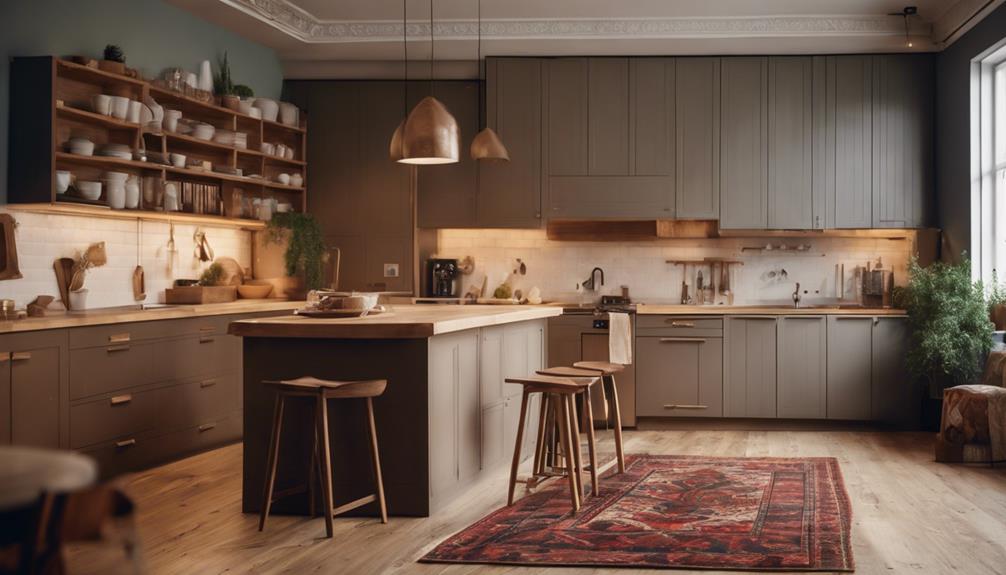
When choosing flooring for your Scandinavian kitchen, consider engineered hardwood with a light finish for a bright, warm feel.
If you want added comfort, cork flooring can bring warmth underfoot while maintaining a sleek look.
For a more modern touch, polished concrete offers durability and a clean aesthetic that fits perfectly in a minimalist design.
Engineered Hardwood With Light Finish
Engineered hardwood with a light finish creates an airy atmosphere in your kitchen, perfectly aligning with the essence of Scandinavian design. This flooring option enhances the spacious feel typical of Scandinavian interiors, making your kitchen bright and inviting.
Engineered hardwood floors combine a core of plywood or high-density fiberboard with a top layer of real wood, giving you the beauty of solid wood while ensuring durability and moisture resistance. You'll appreciate that light-finished engineered hardwood is less prone to showing scratches, dents, and wear, making it a practical choice for high-traffic areas like your kitchen.
With various wood species available, such as oak and maple, you can easily complement any color palette—from soft pastels to vibrant accents—within your Scandinavian design.
Installation is versatile, too; whether you prefer a floating, glue-down, or nail-down method, engineered hardwood fits into different kitchen layouts and preferences seamlessly.
Cork Flooring for Warmth
Cork flooring offers a warm, inviting touch to your Scandinavian kitchen, perfect for those chilly months. This eco-friendly option provides natural insulation, helping to keep your space cozy when temperatures drop. The unique cellular structure of cork flooring not only traps warmth but also absorbs sound, creating a quieter environment—ideal for family gatherings or cooking adventures.
Durability is another standout feature of cork flooring. It can withstand heavy foot traffic, making it resilient enough for your bustling kitchen. Plus, you'll appreciate the variety of colors and patterns available, allowing you to personalize your design while complementing the vibrant accents typically found in Scandinavian interiors.
Being a natural material, cork flooring is hypoallergenic and resistant to mold, which enhances your kitchen's indoor air quality. This means you can enjoy a healthier cooking and dining experience without compromising on style.
Polished Concrete for Durability
Polished concrete flooring stands out for its exceptional durability, making it an ideal choice for the high-traffic areas of your Scandinavian kitchen. This flooring option resists scratches and stains, ensuring it can withstand the hustle and bustle of everyday life without losing its appeal.
Plus, its ability to reflect light enhances the brightness of your space, seamlessly complementing the minimalist aesthetic that defines Scandinavian design.
You'll appreciate the low-maintenance aspect of polished concrete, as it requires only occasional cleaning and sealing to keep it looking fresh. With various finishes and colors available, you can easily customize your flooring to align with your vibrant or muted color schemes.
Additionally, polished concrete has thermal mass properties, which means it can help regulate indoor temperatures, contributing to energy efficiency in your home. This not only keeps your kitchen comfortable but also can lead to savings on energy bills.
If you're looking for a flooring option that combines style, durability, and practicality, polished concrete is definitely worth considering for your Scandinavian kitchen.
Conclusion
You don't have to stick to an all-white palette for your Scandinavian kitchen.
Embrace color and personality by incorporating vibrant fixtures, bold decorative elements, and unique flooring choices.
By mixing essential furniture with eye-catching accents, you'll create a warm and inviting space that reflects your style.
Remember, the heart of your kitchen should be a reflection of you, so let your creativity shine and enjoy the process of making the space truly yours!
Home Decor
Natural Elements in Home Decor – You Won’t Believe the Transformation!
Discover how incorporating natural elements can profoundly change your home decor, leaving you amazed by the transformation that awaits!
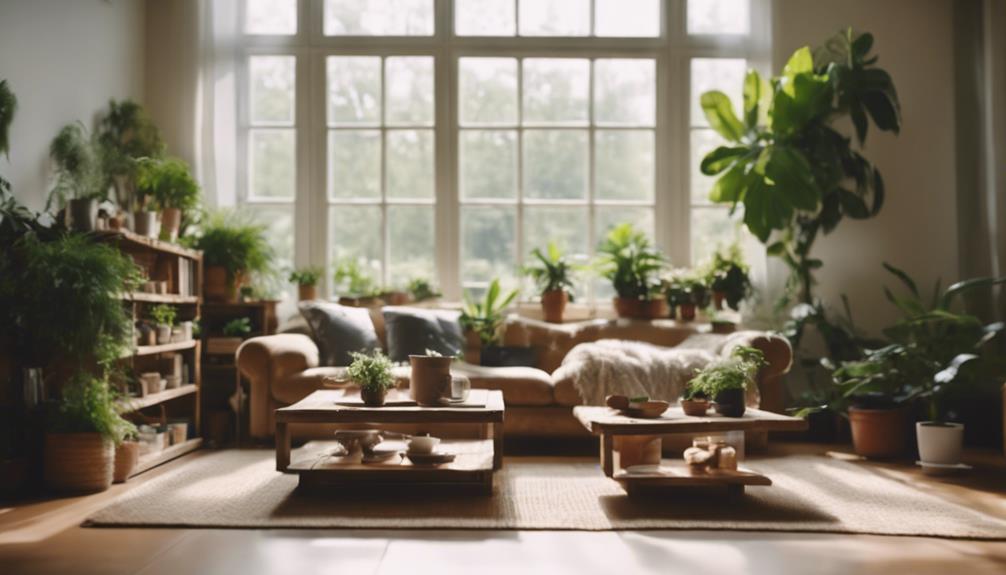
Bringing natural elements into your home decor can create a stunning transformation, both visually and emotionally. Think about adding indoor plants to purify the air and boost your mood. Incorporate earthy tones and textures to foster relaxation and warmth. Large windows can invite natural light, making your space feel more open and inviting. Simple touches like jute rugs or reclaimed wood can add unique character and connection to nature. Embracing these ideas not only enhances your home's beauty but also supports your well-being. There's a wealth of creative strategies to explore further, revealing even more inspiring transformations.
Key Takeaways
- Incorporating large windows floods spaces with natural light, significantly uplifting mood and reducing feelings of anger and sadness.
- Indoor plants not only filter pollutants but also enhance creativity and productivity, creating a healthier living environment.
- Using earthtone colors and organic materials fosters a calming atmosphere, promoting relaxation and overall well-being.
- Seasonal decor updates allow you to celebrate nature's beauty, evoking cherished memories and making spaces more inviting.
The Impact of Natural Elements
Incorporating natural elements into your home decor can elevate your mood and wellbeing, making your living space feel more inviting and peaceful.
When you embrace interior design that prioritizes natural light, you not only enhance the visual appeal of your home but also foster a healthier environment. Large windows that let in sunlight can improve your emotional state, reducing feelings of anger and sadness.
Adding indoor plants is another effective strategy. They filter pollutants from the air, promoting better air quality and, in turn, boosting your overall mood.
Choosing earthtone paint colors and using materials like wood and stone can create a calming atmosphere, encouraging relaxation and tranquility in your daily life.
Furthermore, a thoughtfully designed layout that highlights natural views and elements can strengthen your connection to the outdoors, enriching your living experience. This connection not only enhances your home's aesthetics but can even increase its property value.
Designing With Nature in Mind
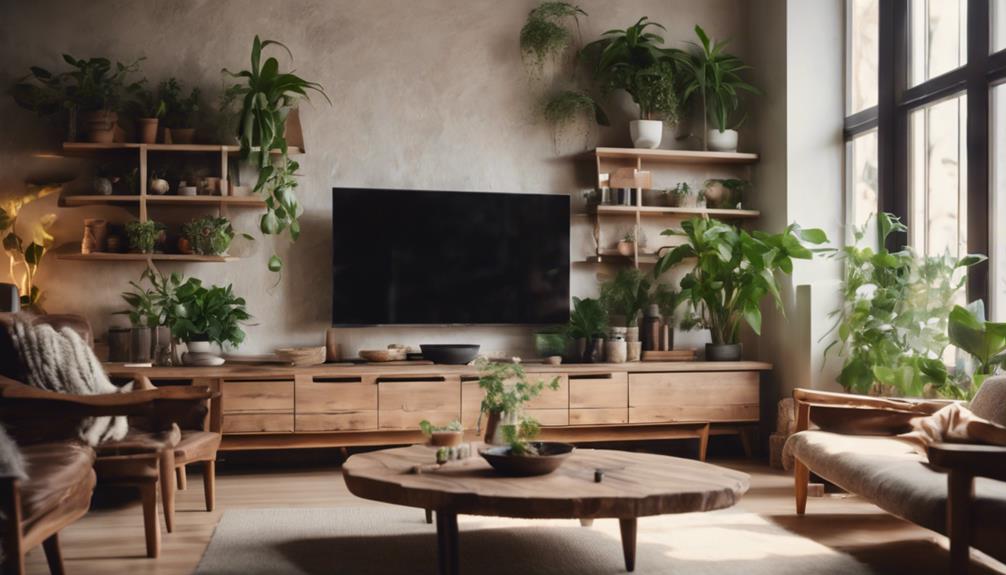
When you design with nature in mind, you embrace the benefits of natural decor that promotes well-being and tranquility.
You can draw inspiration from seasonal changes and select sustainable materials that not only look good but also support the environment.
Let's explore how these elements can transform your space into a harmonious retreat.
Benefits of Natural Decor
How can natural decor transform your living space into a sanctuary that boosts your emotional well-being? By incorporating natural home decor, you create a peace environment that fosters relaxation and reduces stress. The use of organic materials like wood and stone introduces unique natural textures that enhance warmth and comfort in your home.
Here's a quick overview of the benefits:
| Benefit | Description |
|---|---|
| Stress Reduction | Proximity to nature lowers stress levels. |
| Improved Air Quality | Plants filter pollutants, enhancing your space. |
| Enhanced Creativity | Natural elements inspire creativity and productivity. |
Designing with earthy tones and organic shapes not only beautifies your space but also nurtures a deeper connection to nature. This connection is linked to increased happiness and overall well-being. By bringing in these elements, you'll notice a transformation in your atmosphere, making it more inviting and vibrant. Embrace natural decor to uplift your spirits and create a sanctuary that reflects tranquility and harmony.
Seasonal Design Inspirations
Embrace the beauty of each season by infusing your home with decor that reflects nature's vibrant changes throughout the year. Seasonal design inspirations can transform your space, making it feel alive and connected to the environment.
For autumn, consider decorating your home with warm colors, using items like fallen leaves and pinecones to create a cozy atmosphere. In spring, fresh flowers bring a sense of renewal and joy, brightening your interior with their natural beauty.
Updating your decor seasonally not only celebrates the passing of time but also fosters a deeper connection to the natural world. You'll find that crafting with natural materials, such as wreaths made from moss or tree bark, adds an eco-friendly touch to your home.
This practice encourages creativity while enhancing emotional well-being, evoking cherished memories tied to each season.
Sustainable Material Choices
Choosing sustainable materials for your home decor not only enhances its beauty but also aligns your space with environmentally conscious practices. By making thoughtful decisions about your materials, you contribute to a healthier planet while creating a unique atmosphere in your home.
Feel the warmth of reclaimed wood, telling a story of its past.
Experience the comfort of natural fibers like jute and linen, wrapping your space in serenity.
Embrace eco-friendly materials with Environmental Product Declarations (EPDs), ensuring your choices meet sustainability criteria.
Enjoy the beauty of upcycled design, reducing waste and adding character to your decor.
Incorporating sustainable material choices, such as wood, stone, and clay, supports environmental conservation through responsible sourcing.
Prioritizing local sourcing reduces carbon footprints and fosters a connection to your community and ecosystem.
By choosing biodegradable and renewable textiles, you not only create a calming atmosphere but also contribute to reducing landfill waste.
Your decor can be a reflection of your values—choose wisely and transform your home into a haven that respects nature while showcasing your style.
Creative Ways to Bring Nature Indoors
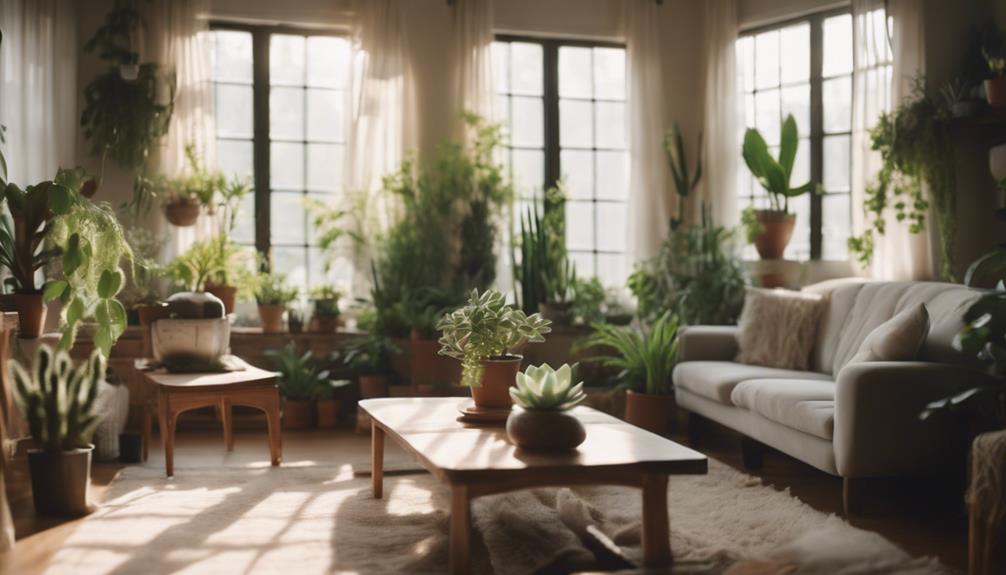
Bringing nature indoors can transform your space in exciting ways. You can use seasonal decor, incorporate indoor plants, and choose natural materials to create a fresh, inviting atmosphere.
Each element not only enhances your home's aesthetic but also boosts your well-being.
Seasonal Decor Ideas
Transform your home with seasonal decor that showcases the beauty of nature, making your space feel warm and inviting throughout the year.
By incorporating seasonal decor ideas, you can easily bring nature indoors and create a harmonious atmosphere that reflects each season's essence. Interior designers often recommend switching up your decor to keep it fresh and dynamic, allowing you to connect with the changing environment.
Here are some creative ways to evoke emotion through your seasonal decor:
- Autumn leaves scattered in a bowl or as a centerpiece for a cozy vibe.
- Fresh spring flowers arranged in vibrant vases to breathe life into your space.
- Pinecones and acorns used in wreaths or table displays to celebrate fall's charm.
Engaging in eco-friendly crafting with these natural elements not only enhances your decor but also promotes sustainability.
Indoor Plant Benefits
Indoor plants not only elevate your home's aesthetic but also offer a host of health benefits that can enhance your overall well-being. By filtering harmful pollutants like carbon monoxide and formaldehyde, these indoor plants greatly improve air quality, making your living space healthier. When you surround yourself with greenery, you can reduce your stress levels by up to 30%, creating a more peaceful environment that fosters relaxation and productivity.
Plants such as snake plants and peace lilies are particularly effective at removing toxins and thrive even in low-light conditions, making them perfect for any room. Adding greenery can also boost humidity levels, helping to prevent dry skin and respiratory issues. Plus, having indoor plants can enhance your creativity and focus by up to 15%, which is especially beneficial in workspaces or study areas.
Incorporating indoor plants into your decor not only beautifies your home but also cultivates a nurturing space that promotes well-being. So, why not bring the outdoors in and enjoy the transformative benefits of nature right at home?
Natural Material Textures
Natural materials like wood, stone, and clay create an inviting atmosphere that instantly connects your home to the beauty of the outdoors. By incorporating these elements, you can effortlessly add warmth and character to your space.
Here are some creative ways to integrate natural material textures into your decor:
- Reclaimed wood furniture: Each piece tells a story and brings a rustic charm.
- Natural stone accents: Use a stone coffee table or backsplash for a touch of elegance.
- Linen curtains: They soften light and evoke a sense of calm.
Layering various natural textures fosters a cohesive look while enhancing your home's overall aesthetic. For instance, pair a jute rug with wooden furniture and linen curtains to create a dynamic and inviting environment.
Sustainable sourcing of these materials not only benefits the planet but also guarantees that each item is unique. By bringing these natural elements indoors, you'll cultivate a tranquil space that resonates with comfort and connection to nature.
Embrace the beauty of natural material textures, and watch your home transform into a serene retreat.
Benefits of Open Concept Spaces
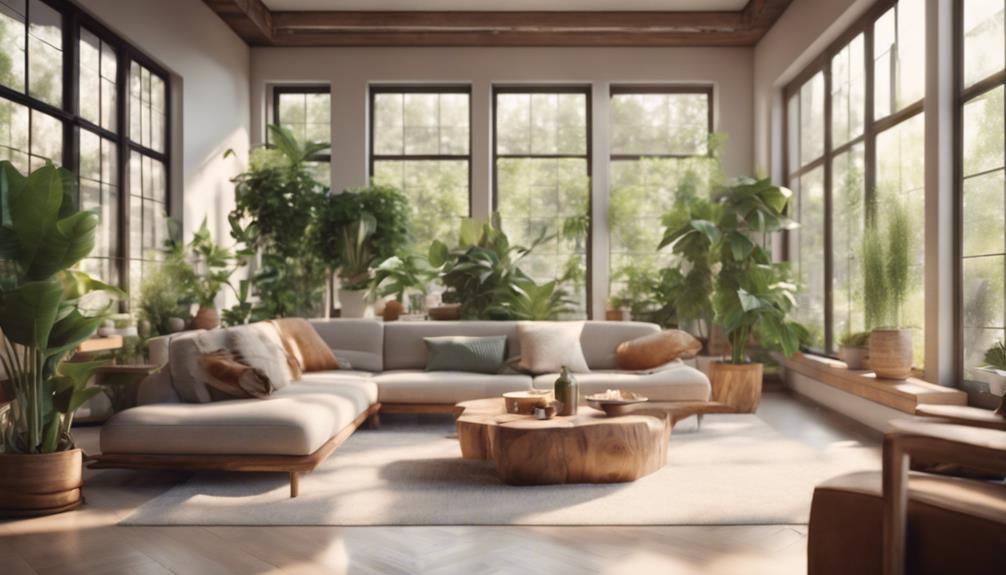
Open concept spaces invite more natural light into your home, creating a brighter atmosphere that boosts your mood and overall well-being. By removing non-load-bearing walls, these layouts enhance the flow of light and promote social interaction among family members, fostering a sense of community. You'll enjoy a seamless connection between your indoor and outdoor environments, maximizing landscape views and increasing your property value.
Living in an open concept design can also alleviate feelings of confinement, particularly in urban settings. The spaciousness of these areas creates a liberating living experience that feels more connected to the natural environment around you. Additionally, integrating natural elements like large windows or indoor plants enhances airflow, contributing to tranquility and emotional well-being.
In essence, open concept spaces not only brighten your home but also elevate your overall lifestyle. You're not just investing in a beautiful design; you're actively enhancing your quality of life by embracing a layout that encourages light, interaction, and a connection to nature.
Achieving Harmony in Decor
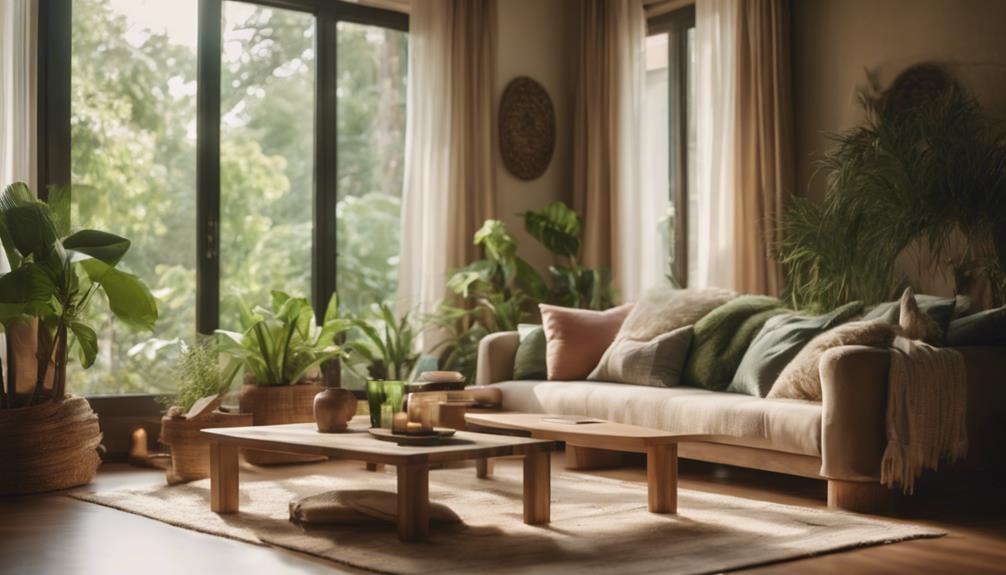
Balancing colors, textures, and materials in your decor helps create a harmonious space that feels both inviting and calming. To achieve this, focus on incorporating natural elements like wood, stone, and plants. These organic materials not only enhance tranquility but also foster a connection to nature.
Consider these aspects to evoke emotion in your space:
- Warm earthy tones that radiate comfort and coziness
- Cool colors that promote a serene and peaceful atmosphere
- Varied textures like soft fabrics and smooth surfaces for visual interest
Crafting With Natural Materials
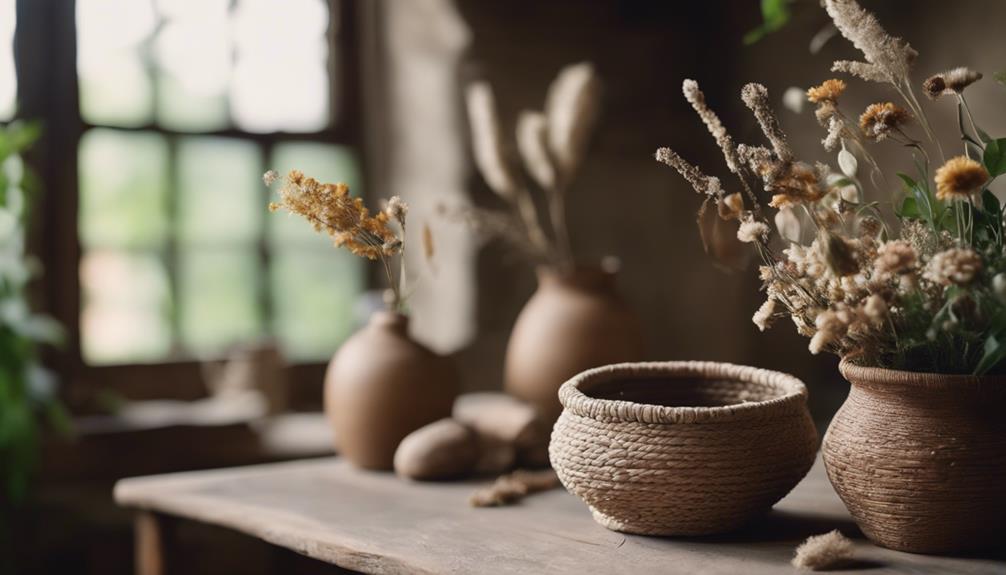
Incorporating handcrafted decor into your space not only enhances its beauty but also nurtures a deeper connection to nature through the use of sustainable materials. Crafting with natural materials like leaves, moss, and tree bark allows you to create unique, eco-friendly decor that stands out.
For instance, you can press leaves to make vibrant bookmarks or string them into decorative garlands, adding rich colors and textures to your home.
Moss is another versatile choice. You can use it to craft beautiful terrariums, centerpieces, or even moss wreaths, effortlessly bringing a touch of nature indoors with minimal upkeep.
Additionally, consider using tree bark harvested from fallen trees. It can be transformed into rustic picture frames or shelving units, infusing your living spaces with warmth and character.
Seasonal Decor Inspiration
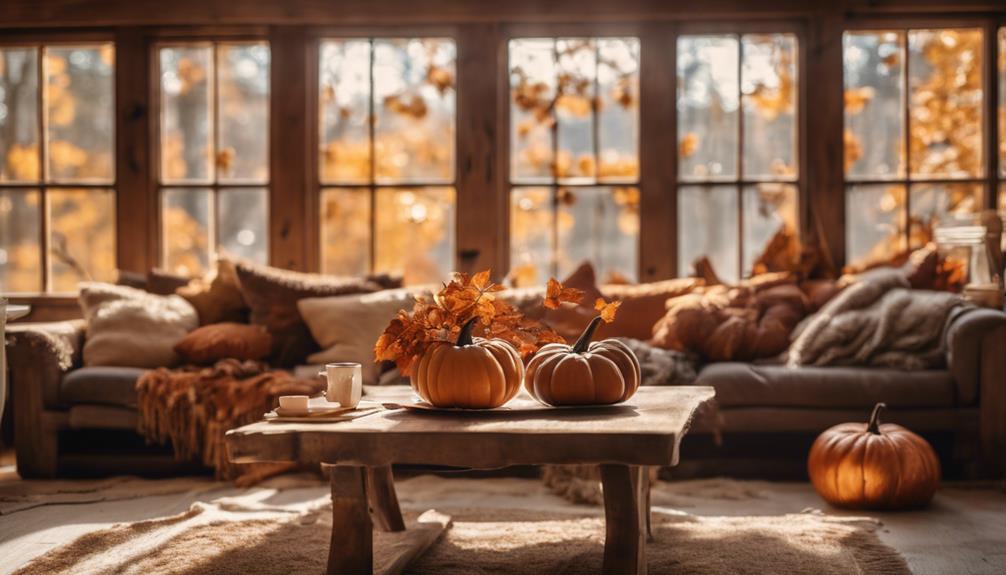
Seasonal decor inspiration draws on nature's bounty, allowing you to refresh your home with vibrant elements that reflect the changing times of the year. By incorporating seasonal natural materials, you can create a warm and inviting atmosphere that evolves with each season. This not only enhances the festive spirit but also helps you connect with nature as you embrace the beauty around you.
Consider these inspiring ideas for your seasonal decor:
- Use autumn leaves to create stunning centerpieces.
- Gather pinecones and acorns for charming winter crafts.
- Arrange spring flowers for colorful displays that brighten your space.
Rotating these decorations regularly keeps your decor dynamic and engaging. Plus, crafting with seasonal items, like making leaf prints or moss arrangements, can be a fun way to express your individuality.
By tapping into seasonal decor inspiration, you're not just beautifying your home; you're fostering a deeper connection to the environment and celebrating the rich textures and colors that nature offers throughout the year.
Embracing Sustainability in Design
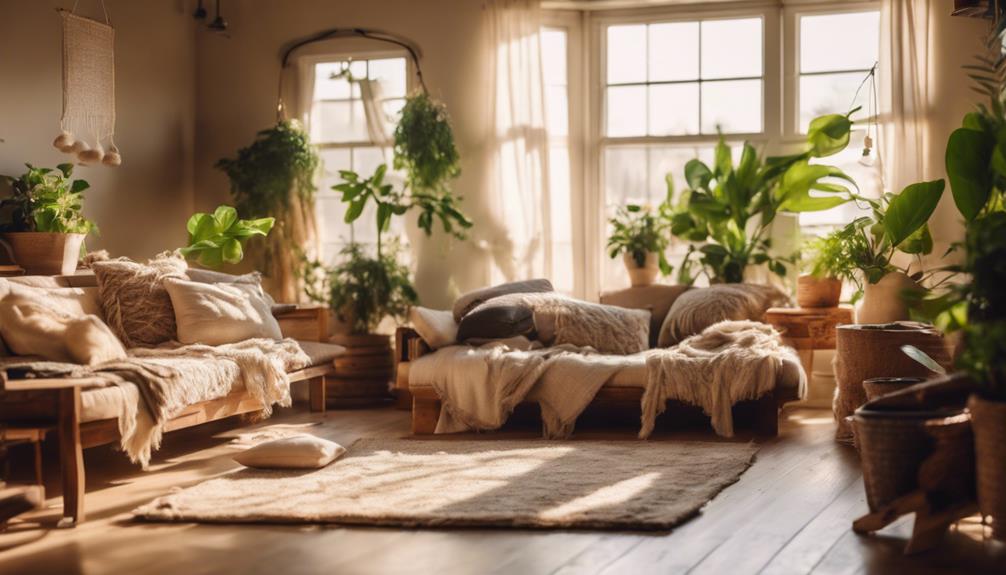
As you refresh your home with seasonal decor, consider how embracing sustainability in design can additionally enhance your living space while protecting the environment. By opting for eco-friendly materials like reclaimed wood and natural fibers, you can reduce your carbon footprint and promote conservation. Sustainable products often come with Environmental Product Declarations (EPDs), which provide transparency about their environmental impacts, helping you make informed choices.
Incorporating natural decor not only beautifies your home but also supports local ecosystems. Using non-toxic materials guarantees a safer environment for you and your family. Moreover, implementing sustainable practices like recycling and upcycling fosters creativity, allowing you to craft unique pieces while minimizing waste.
The beauty of sustainable design lies in its ability to spark conversations about our responsibility to the planet. Every time you choose eco-friendly materials or sustainable products, you encourage awareness and appreciation for the environment.
Community and Nature Connection
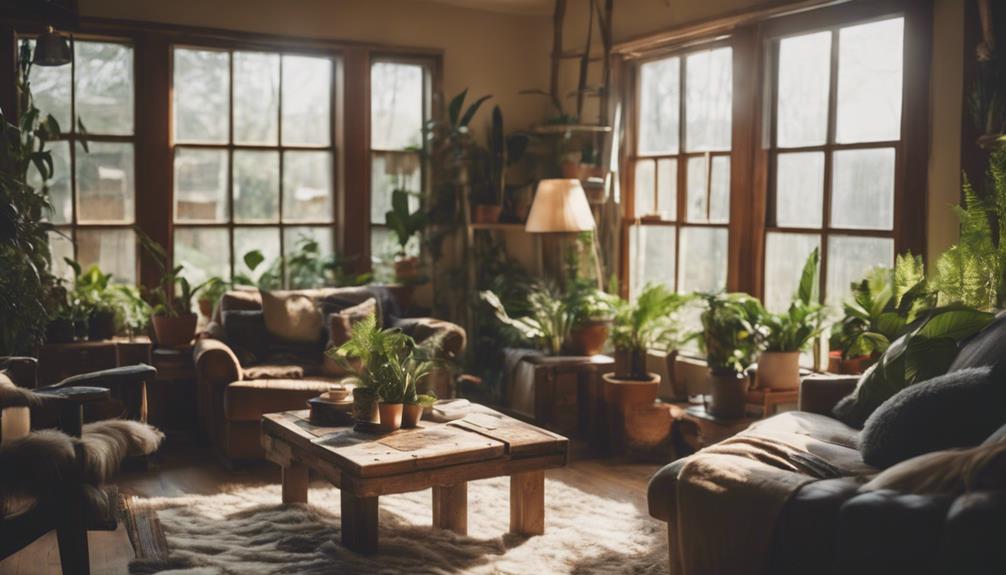
Connecting with your community through nature not only enriches your living space but also strengthens bonds and promotes sustainability. Engaging in activities like community gardens lets you cultivate plants while fostering biodiversity. You'll find that these interactions enhance your appreciation for nature and create a sense of belonging.
Consider these emotional benefits:
- Shared joy of harvesting fresh produce with neighbors
- Creative collaboration in local workshops, releasing your artistic side
- Inspiration from others through social media groups showcasing natural decor
When you actively participate in these initiatives, you're not just improving your home; you're supporting local artisans and craftspeople, which enriches your community's economy.
By incorporating handcrafted, natural elements into your decor, you celebrate unique designs that reflect your collective values. This connection to nature and community creates a ripple effect, encouraging sustainable practices that benefit everyone.
Frequently Asked Questions
What Are Home Decor Mistakes to Avoid?
Avoid overcrowding your spaces, neglecting natural light, and ignoring color harmony. Guarantee every decor item has a purpose, and don't forget to refresh your decor seasonally to keep your home feeling vibrant and inviting.
What Is Trending in 2024 Home Decor?
In 2024, you'll see biophilic design take center stage, with earthy colors, sustainable materials, and multifunctional furniture. Open-concept layouts will dominate, creating seamless connections between indoor and outdoor spaces while boosting your home's overall aesthetic.
What Are Natural Materials to Decorate?
To decorate, you can choose wood for warmth, stone for durability, and clay for creativity. Incorporate jute for texture, linen for softness, and bamboo for sustainability. Each material brings unique beauty and character to your space.
Why Use Natural Materials in Interior Design?
Using natural materials in interior design enhances warmth, promotes tranquility, and fosters a connection to nature. These elements not only improve your space's aesthetics but also boost your emotional well-being and creativity, making your environment more inviting.
Conclusion
Incorporating natural elements into your home decor can truly transform your space, making it feel more inviting and serene.
Did you know that studies show people who live in homes with plenty of natural light and greenery report a 20% increase in overall happiness?
By designing with nature in mind and embracing sustainable materials, you're not just beautifying your home; you're enhancing your well-being.
So, go ahead and bring the outdoors in—your spirit will thank you!
-

 Vetted2 months ago
Vetted2 months ago14 Best Personalized Father's Day Gifts for Your Husband – Show Him You Care
-

 Alfresco1 month ago
Alfresco1 month agoAlfresco Stacker Doors: Seamless Indoor-Outdoor Living!
-

 Craft and Textiles3 months ago
Craft and Textiles3 months ago15 Best Places to Buy Appliances for Your Home – Top Retailers Reviewed
-

 Decorative Throws3 months ago
Decorative Throws3 months agoIs It Better to Dry Clean Blankets?
-

 Tableware and Dining Accessories3 months ago
Tableware and Dining Accessories3 months agoWhat Is the Meaning of the Word Tableware
-

 Tableware and Dining Accessories3 months ago
Tableware and Dining Accessories3 months agoWhat Is the Hindi Meaning of Tableware
-

 Craft and Textiles3 months ago
Craft and Textiles3 months ago15 Best Cordless Mowers for Effortless Lawn Care – Top Picks of 2024
-

 Craft and Textiles3 months ago
Craft and Textiles3 months ago15 Best Battery-Powered Leaf Blowers for Effortless Yard Work
























